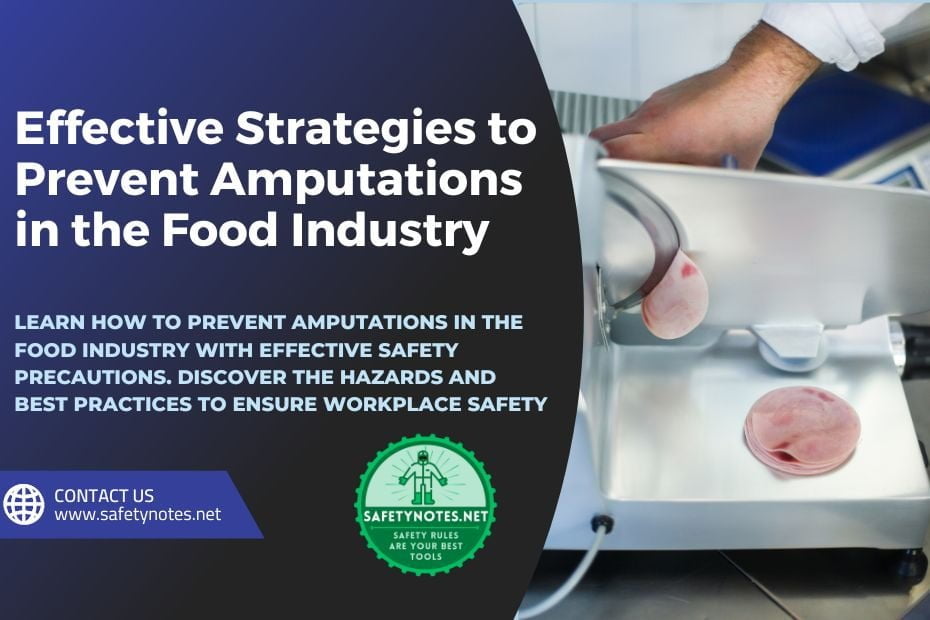
The food industry is a dynamic and fast-paced environment that involves various processes and machinery. However, it also poses certain risks, including the potential for amputations. Amputations can occur when workers come into contact with moving machinery, sharp tools, or pinch points. To ensure the safety of employees and prevent amputations, it is crucial to implement effective safety precautions. This article will explore the hazards leading to amputations in the food industry and provide comprehensive safety measures to prevent such incidents.
Understanding Amputations in the Food Industry

Amputations involve the partial or complete removal of a body part, such as a finger, hand, or arm. In the food industry, amputations can result from various hazards, including:
- Machinery and equipment: Workers operating machinery like meat slicers, mixers, grinders, and cutting tools are at risk of amputations if proper safety measures are not in place.
- Pinch points: These are areas where workers’ body parts can get caught between moving parts of machinery or between machinery and a fixed object. Pinch points can cause severe injuries, including amputations.
- Conveyor belts: Workers can get their hands or fingers caught in conveyor belts, leading to amputations. Proper guarding and safety protocols are essential to prevent such incidents.
- Tools and knives: Improper use or handling of tools and knives can result in severe cuts or amputations. Workers must receive adequate training on safe handling techniques.
Safety Precautions to Prevent Amputations
To mitigate the risk of amputations in the food industry, it is crucial to implement the following safety precautions:
Food Slicer Safety
- Awareness of Blade Dangers: When utilizing food slicers, whether they are actively in use or powered down but still connected to a power source, it’s crucial to be aware of the potential dangers associated with the upper and lower sections of the slicer. These areas pose a serious risk to workers, as fingers and hands can inadvertently come into contact with the blade, leading to severe cuts or even amputations.
- Protective Guards: To ensure the safe use of rotary blade food slicers, it is imperative to employ protective guards that cover the unused segments of the slicer blade both above and below the slicer. Employers should either acquire slicers that come equipped with a feeding attachment on the food holder sliding mechanism or separately purchase and install this attachment prior to use.
- Worker Training:
- Never insert a hand behind the food chute guard.
- Avoid manually inserting food into the slicer or applying hand pressure during operation.
- Utilize a pushing or guarding device in conjunction with chute-fed slicers.
- Employ plungers to feed food into chute-fed slicers, or utilize the provided feeding attachment on the food holder.
- Always power off the food slicer when transitioning between different food items.
- Keep hands away from the danger zone at the back of the blade where the sliced food exits.
- Ensure that slicers are turned off and unplugged when not in active use or when left unattended for any duration.
Meat Grinder Safety
- Primary Safeguard: Preventing worker injuries when operating a meat grinder requires employers to take certain precautions. Specifically, meat grinders must be retrofitted with a primary safeguard, such as a properly designed tapered throat or a fixed guard, if there is any possibility that a worker’s hand could come into contact with the point-of-operation, which is the area around the auger cutter.
- Worker Training:
- Exclusively use a suitable plunger when feeding meat into grinders.
- Operate grinders only when feeding trays and throats are properly installed.
- Use the meat grinder solely for its intended purpose.
- Always turn off and unplug grinders when they are not in active use or when they will be left unattended for any period of time.
Training and Education
Proper training and education are fundamental in preventing amputations. All employees should receive comprehensive training on the safe operation of machinery and equipment specific to the food industry. Training programs should cover:
- Proper handling and use of machinery, tools, and knives
- Identification of amputation hazards and how to avoid them
- Importance of following safety procedures and using personal protective equipment (PPE)
- Emergency response procedures in case of an amputation or other serious injury
Regular refresher courses and ongoing training are essential to reinforce safe work practices and keep employees updated on new safety procedures and regulations.
Machine Guarding and Lockout/Tagout Procedures
Machine guarding is crucial to prevent workers from coming into contact with moving parts of machinery. Employers should install appropriate machine guards that are securely in place and not easily bypassed. Guards should be designed to prevent access to hazardous areas and should be regularly inspected to ensure their effectiveness.
Lockout/tagout procedures are essential when performing maintenance or repair work on machinery. These procedures involve shutting down and de-energizing machinery to prevent accidental startup. Proper training and clear communication of lockout/tagout procedures are vital to protect workers from amputation hazards.
Personal Protective Equipment (PPE)
Personal protective equipment plays a crucial role in preventing amputations. Employers should provide and enforce the use of appropriate PPE, including:
- Cut-resistant gloves: These gloves provide protection against sharp objects and tools commonly used in the food industry.
- Safety glasses: Eye protection is essential to prevent injuries from flying debris or chemicals.
- Steel-toed boots: Foot protection is necessary to prevent crushing injuries from heavy objects or machinery.
Proper training on the correct use and maintenance of PPE should be provided to all employees.
Safe Work Practices
Implementing safe work practices is essential to prevent amputations. Some key practices include:
- Using push sticks or tools to feed materials into machinery, keeping hands and fingers away from pinch points.
- Using proper cutting techniques with knives and other sharp tools.
- Avoiding loose clothing or jewelry that can get caught in machinery.
- Maintaining good housekeeping to prevent slips, trips, and falls that can lead to amputations.
Regular reminders and ongoing supervision can help ensure that safe work practices are followed consistently.
Regular Maintenance and Inspections
Regular maintenance and inspections of machinery and equipment are crucial to identify and address potential hazards. Employers should establish a maintenance schedule and conduct inspections to:
- Identify any loose or damaged parts that could pose a risk of amputation.
- Ensure that safety features, such as machine guards and emergency stop buttons, are in proper working condition.
- Lubricate moving parts to prevent malfunctions that could lead to amputations.
Prompt maintenance and repairs are essential to ensure the safe operation of machinery.
Reporting and Investigation of Incidents
Establishing a system for reporting and investigating near-miss incidents, accidents, and injuries related to amputations is vital. This helps identify root causes and implement corrective measures to prevent future incidents. Encourage a culture of reporting and learning from incidents to continuously improve safety.
Emergency Response Procedures
Develop and communicate emergency response procedures in case of an amputation or other serious injury. This includes providing first aid training to designated employees and ensuring the availability of first aid kits and emergency contact information. Regular drills can help employees familiarize themselves with the procedures and respond effectively in an emergency.
Ergonomics and Workstation Design
Consider ergonomic principles when designing workstations to reduce the risk of repetitive motion injuries and accidents. This includes:
- Ensuring proper height and positioning of equipment to minimize strain on workers’ bodies.
- Providing anti-fatigue mats and adjustable work surfaces where applicable.
- Designing workstations with clear visibility and adequate lighting to enhance safety.
Importance of Communication and Supervision
Effective communication and supervision are essential in preventing amputations. Employers should:
- Clearly communicate safety procedures and expectations to all employees.
- Encourage open dialogue and feedback regarding safety concerns.
- Provide ongoing supervision to ensure that employees follow safety protocols and use equipment correctly.
Continuous Improvement and Safety Culture
Regularly review and update safety protocols and procedures based on feedback from employees, safety inspections, and industry best practices. Encourage a culture of continuous improvement and employee involvement in safety initiatives. Regular safety meetings and training sessions can help reinforce the importance of safety and foster a proactive safety culture.
Conclusion
Preventing amputations in the food industry requires a comprehensive approach that includes training, proper machine guarding, personal protective equipment, safe work practices, regular maintenance, and a strong safety culture. By implementing these safety precautions, employers can create a safer working environment and protect their employees from amputation hazards.
FAQs
How can training and education help prevent amputations?
Training and education provide employees with the knowledge and skills to identify amputation hazards, follow safety procedures, and use equipment correctly, reducing the risk of amputations.
What is the importance of machine guarding and lockout/tagout procedures?
Machine guarding prevents workers from coming into contact with moving parts of machinery, while lockout/tagout procedures ensure machinery is properly shut down and de-energized during maintenance or repair work, preventing accidental startup and amputations.
What types of personal protective equipment (PPE) should be used to prevent amputations?
Cut-resistant gloves, safety glasses, and steel-toed boots are essential PPE to protect against amputation hazards in the food industry.
How can a culture of continuous improvement contribute to preventing amputations?
A culture of continuous improvement fosters ongoing evaluation of safety protocols, employee involvement in safety initiatives, and the implementation of best practices, leading to a safer work environment and reduced risk of amputations.


